Author: Stacy Muur Translation: Shan Ouba, Golden Finance
People rarely leave because a protocol has problems. More often, they leave because the story is no longer developing - there are no new beliefs to follow, no new directions to align.
Web3 is a world, and the "Web3 protagonist halo" is another level.
That moment when a protocol suddenly becomes popular and the timeline is full of its news, and every project is either integrating it or copying it. You must know that feeling.
FriendTech had that moment. Pump.fun definitely had it. Farcaster, Bananagun, and Unibot also had it, each in their own cycle and for different reasons.
The feeling is direct, fast, and noisy.
But the harder truth is: the heat always shifts. Not because the product fails, but because people find a new, flashier toy. Novelty has a very short shelf life, and in the world of Web3, the spotlight never stays for long.
This article is not a eulogy. Not all of these protocols are "dead". But they all went through the same process - from dominance to silence. This article is about what the projects that once had the halo of protagonists look like when they are no longer making headlines.
Who are we talking about
I've been in this circle long enough to have seen this pattern: a protocol explodes, dominates the entire timeline, and then fades away quietly and silently. This chart is a snapshot, and it is not a measure of success in terms of TVL or token price, but a measure of things that are harder to capture: attention, memory points, emotional resonance. These projects once dominated the timeline. Some, are still holding on.
For example, FriendTech, its rise was fast and loud, but its collapse was also complete - no roadmap, no user stickiness, no recovery track. Once the heat was over, it turned directly into a burden.
Look at Unibot: it survived hacks, clones and market weakness, but it is still regarded as one of the cleanest and most useful trading user experiences.
And Virtuals, one of the few projects that not only "survived" but also completed "transformation". It started as a prediction game based on the Base chain, but now calls itself "Wall Street of AI agents". This kind of transformation is very rare in the crypto world, let alone in those projects born in the degen gambling field.
Pump.fun and Maestro are another story: not dead, just diluted. They are still operating and have occasional peaks of activity, but no one calls them revolutionary projects anymore. Memecoin machines and sniper robot networks were not designed to last long from the beginning, they were just designed to "explode". And they did explode - just not a second time.
Then there are the "slow-burning" projects: Grass, DeBank, Farcaster. They each have their own "presence" - speculative returns, DeFi social identity, decentralized conversations. They are not ostentatious, nor do they disappear, but quietly and intentionally continue to build outside the craze.
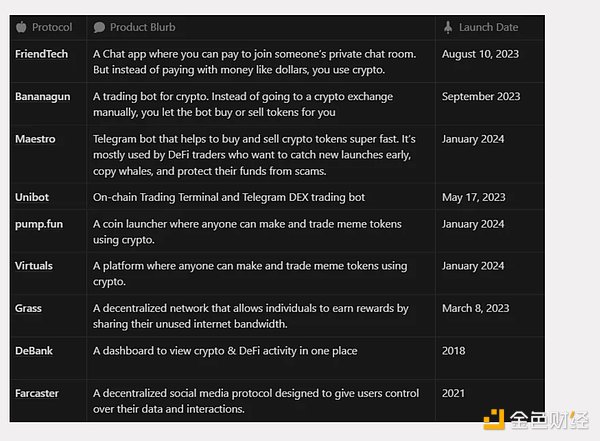
Still building, still iterating
If the previous table is a mapping of "cultural gravity", then this table records something else entirely: resilience. Because heat is noisy, and real construction is often quiet.
Some of these protocols are no longer "hot", but they have not stopped. This table reveals those projects that have been out of the public eye but are still continuing to release updates, expand integration or strengthen infrastructure.
FriendTech? It was officially shut down in September 2024.
But what about the others? They are quietly accumulating compound interest - not in the timeline, but in the changelog.
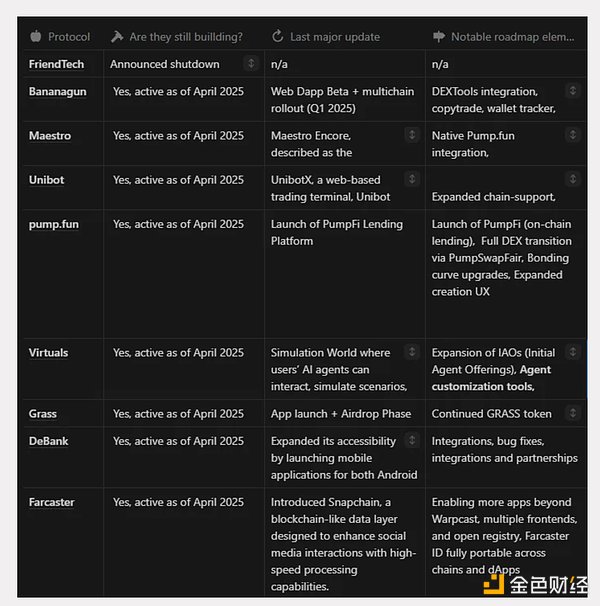
Peak activity ≠ persistent correlation
You can always feel the peak coming. Telegram group messages are flooded to the point where you can't scroll. CT is filled with copy traders and half-baked posts. The protocol's UI collapses under the weight of its own hype.
But sustaining that status quo? That’s another story.
Let’s analyze what the data shows, not about what was promised, but about actual user behavior.
Virtuals
Virtuals proxy creation peaked in October 2024, with more than 60 proxies created per day, followed by a wave of experiments in November and December. By early 2025, daily proxy creations were down to single digits.

Bananagun
Bananagun peaked at 700 million active in July 2024.
Nine months later? Just 124.6 million. That’s down 82%.
It’s still active, still shipping, but it’s no longer a top choice. Telegram bots flooded the market, sniping trades became standard, and the narrative had shifted. Bananagun didn’t collapse, it just faded.
DeBank
DeBank experienced a surge in multichain registrations in mid-2023, then flattened out completely. By early 2024, new users stopped coming. The product itself didn’t collapse, but the narrative itself did. DeFi social sounded good, but people didn’t stick around. Maybe they just followed a few wallets and left.

Farcaster
This is what quiet accumulation looks like. Since the end of 2024, Farcaster has stabilized at between 20,000 and 50,000 daily active users, and user engagement continues. No massive surges, no airdrop bait. Just real usage. While most social protocols are chasing noise, Farcaster cultivates a habit, but the real victory is that people keep coming back.
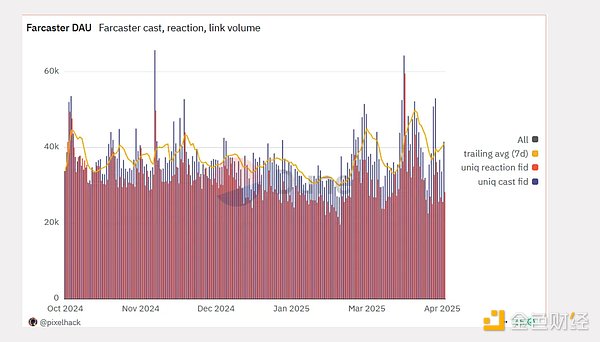
Pump.fun
Pump.fun is a volcano. At the end of 2024, it minted millions of meme coins, with more than 150,000 new wallets appearing every day at its peak. After that, the curve fell sharply. But it did not die, but stabilized at a minting volume of 50,000 to 60,000 per day. Still useful, still interesting. Just no longer the cultural heyday it once briefly became.
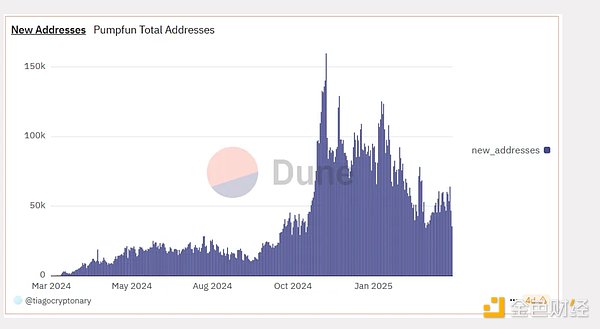
The story of user buy-in
You can track usage on the dashboard. But belief? It lies elsewhere. To understand this, we have to go back in time, to the moments when they made sense. When FriendTech turned social influence into liquidity, Pump.fun felt like a game changer, and Farcaster felt more like a manifesto than a social app.
Those were more than product launches, they were emotional turning points. People didn’t just use these protocols, they bought into them. FriendTech made us feel like early adopters. Pump.fun made us feel smart. Farcaster made us feel like we were part of something cleaner than Twitter.
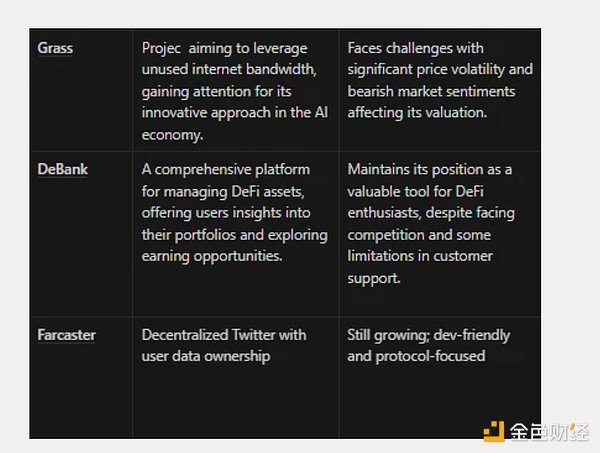
FriendTech
FriendTech’s narrative was compelling: tokenize your social connections, monetize influence. At its peak, it wasn’t just another SocialFi tool, it was identity as an asset. But this story collapsed under its own weight. No roadmap, no engagement loop, no cultural staying power. It was a rare case where usage, narrative, and product disappeared in tandem. A clean rise and a clean death.
Bananagun
The story of Bananagun is about leveling the playing field. Quick sniping, smart token economics, and bots for the average trader. It thrived on the Telegram bot wave, making a name for itself by being sharper and faster than the rest of the competition. Now? It’s still up and running, still serving traders. But it’s become infrastructure, useful but no longer leading the conversation.
Maestro
Maestro positioned itself as the quiet force behind the decentralized finance economy. It didn’t sell trading bots, it sold leverage through infrastructure. But with less than 1% of its launched tokens surviving, the narrative has shifted. Now, it’s more of a cautionary tale of what happens when open infrastructure becomes too open, too fast.
Unibot
Unibot focused on pure speed and precision. It positioned itself as a tool for the sharpest Telegram traders, not just a product but an identity. Despite competition and even a hack, Unibot’s reputation has remained solid. Its functionality has expanded, and its user base has been maintained. Rather than relying on virality, it relied on reliability. And that reputation still stands.
Pump.fun
Pump.fun democratized token creation, and with it the illusion of instant relevance. At its peak, it felt like a new asset class was being created every 10 seconds. But saturation came fast. Today, it’s still active, still minting tokens, but the magic has faded. The story of “everyone could launch” lost its luster after “everyone” launched and most of them disappeared.
Virtuals
Originally a gamified speculation hub that piggybacked on the Base narrative, Virtuals understood attention, then moved beyond it. It pivoted to AI agent coordination, reframing it as something bigger than prediction markets. Now it’s no longer chasing memes, it’s building infrastructure. “Wall Street for AI Agents” is a bolder and more enduring narrative, and it’s one of the few protocols on this list that’s rewriting its own story in real time.
DeBank
DeBank taught us that our DeFi portfolio is our identity. It made tracking wallets social. For a while, that worked. But the story stagnated. The product still functions well and is respected among veteran users, but it never made the leap from tool to network. In a way, DeBank is a victim of its own UX stability, being too good to ignore but not compelling enough to be widely publicized. Farcaster was launched with a big idea: own your connections, own your voice. Rather than trying to clone Twitter, it reimagined how to publish, interact, and build on-chain. Current awareness bears this out: Farcaster is not in decline. It has been slowly accumulating trust and traction, which is exactly what long-tail narratives look like—less viral, but more resilient. Other notable cases of fading momentum In addition to the more notable examples above, there are several protocols that have experienced similar patterns. They gained significant attention, often leading their category for a short period of time, and then saw a noticeable drop in user activity, volume, or relevance. These are not fringe projects. At their peak, they shaped the market narrative and attracted serious attention. This section highlights some of these cases.
Blast
Peaked at 900k MAU during the credits-driven frenzy in July 2024. Now at ~120k. The earnings narrative faded quickly after credit fatigue set in.
Scroll
Reached 1.2m MAU at the peak of zkEVM hype. Currently at ~111k MAU. Still shipping, but the novelty has worn off as infrastructure shifts to a performance-first narrative.
Starknet
Bridge deposits hit $1.6B in TVL season. Now around $390M. Developer-first loyalty remains, but mainstream adoption appears to have slowed due to cost and tooling friction.
Renzo Protocol
MAU peaked at 155K; now just under 19K. Still relevant in the liquidity re-staking space, but overshadowed by larger EigenLayer ecosystem players.
Sushiswap
ATH volume hit $11.3B. Now trading around $200M. It’s a cautionary tale of how decentralized visions, governance creep, and CEX competition can erode first-mover advantage.
All of these protocols were once considered industry leaders. While some are still active, their data suggests that the way users interact with them today has changed. Whether the decline stems from changing market conditions, evolving narratives, or simply increased competition, the lesson is consistent. Early momentum is not the same as long-term existence.
Conclusion
In Web3, most things aren’t dead, they’re just not talked about anymore. The projects in this article weren’t chosen because they failed. They were chosen because they were once important, briefly, and intensely. Then, they quickly disappeared, not because they lost funding or users, but because they lost narrative momentum — the hard-to-measure force that turns a product into action.
The deeper pattern is about the emotional arc of belief. When this arc flattens, users disengage, not because they are disappointed, but because there is no longer a reason to stay.
This is why longevity in Web3 is so rare. To persist, a protocol must be more than usable, it must remain narratively alive. It needs to provide not just benefits or tools, but identity, possibilities, and reasons to come back tomorrow.
The next breakthrough will not come from simply solving a problem, but from giving meaning. And the innovators worth paying attention to are already working quietly in the hustle and bustle, waiting for their second breakthrough.
 Miyuki
Miyuki
 Miyuki
Miyuki Alex
Alex Brian
Brian Brian
Brian Weiliang
Weiliang Miyuki
Miyuki Brian
Brian Weiliang
Weiliang Miyuki
Miyuki Alex
Alex